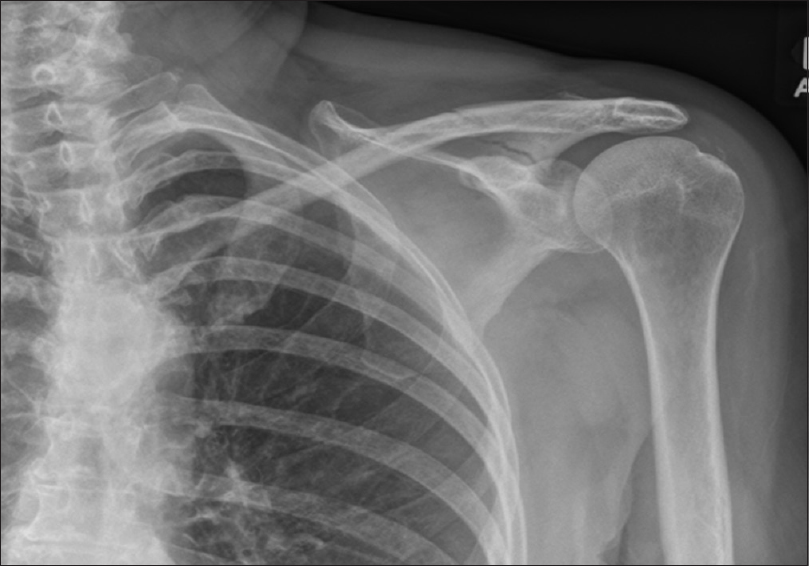Sir,
Osteoporosis results in millions of fractures. [1] It is common among postmenopausal women, and the disease process is characterized by increased bone turnover, progressive loss of bone mass, microarchitectural deterioration, and increased fracture risk. Bisphosphonates, which are antiresorptive drugs, are the most commonly used pharmacologic treatments for postmenopausal osteoporosis. Alendronate, a potent bisphosphonate, decreases bone turnover, increases bone mineral density, and decreases vertebral, nonspine, and hip fracture risk in women with osteoporosis. [2] Atypical stress fractures also known as insufficiency fractures of the proximal femoral shaft have been reported as a side effect in patients taking a long-term bisphosphonate. We report a case of bisphosphonate-associated atypical fracture of nonweight bearing bone scapula in a female patient.
A 69-year-old lady was taking shower when she heard a loud crack from her shoulder. This was accompanied with severe pain. There was no history of fall or direct trauma to shoulder blade. She attended local Accident and Emergency Department where X-ray was done which showed fracture of acromion of scapula [Figure 1]. This fracture was managed non-operatively in a broad arm sling. At 6 weeks review in the fracture clinic, it was found that the patient has been taking alendronic acid for past 10 years. It was stopped and after 3 months of fracture, patient became symptom-free. At 1-year follow-up fracture of scapula has healed and patient is pain-free from shoulder and has acceptable mobility of shoulder joint.

Figure 1: Atypical scapular fracture associated with long-term bisphosphonate use
Osteoporosis causes more than 8.9 million fractures annually worldwide, of which more than 4.5 million occur in the Americas and Europe. The lifetime risk for a wrist, hip, or vertebral fracture has been estimated to be in the order of 30-40% in developed countries. [1]
Oral bisphosphonates are the first-line therapy for the prevention and treatment of osteoporosis in postmenopausal women. A recent study estimated that between 2001 and 2008, 144,670 low-energy fractures were prevented among osteoporotic women who took bisphosphonates in the United States. [3]
However, one of recognized side effects of a long-term bisphosphonate therapy is atypical fracture of the proximal femur.
Because of this serious side effect of a long-term bisphosphonate, need to continue bisphosphonate treatment for osteoporosis should be re-evaluated periodically based on the benefits and potential risks of bisphosphonate therapy for individual patients, particularly after 5 or more years of use. [4]
Scapular fractures are relatively uncommon and generally represent 0.5-1% of all fractures and 3-5% of fractures involving the shoulder girdle. They are usually caused by high-energy vehicular trauma or by falling from a height.
In our case study, the patient was on long-term bisphosphonate and she sustained scapula fracture with no history of trauma. Fracture healed after stopping bisphosphonate treatment. To our knowledge, this is the first case of bisphosphonate-associated scapula fracture.
This case report further emphasizes the need for periodic evaluation of patients on long-term bisphosphonate, especially those who had therapy for more than 5 years or who have sustained an atypical fracture.
Financial support and sponsorship
Nil.
Conflicts of interest
There are no conflicts of interest.
